Menu
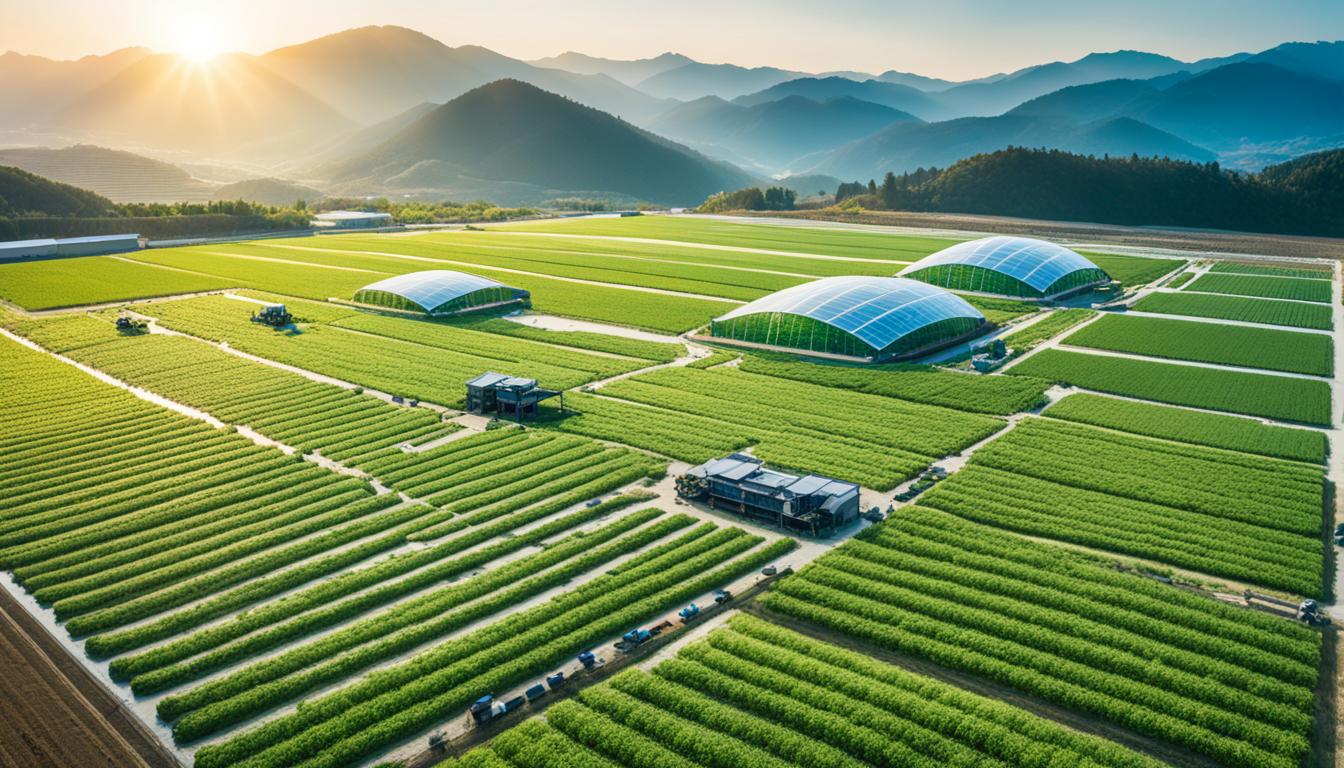
Did you know only 22% of South Korea is the right land for farming? The rest is mountains and cities. Despite this, South Korea is putting KRW 6.2 billion (US$4.7 million) into new farming ideas. The Ministry of Agriculture leads in using tech to fight diseases, reduce farm smells, and make farms more modern.
South Korea is stepping into the future with digital farming. It’s using ICT and AI to make farms better and earn more money. The country is now a leader in smart farming. It’s making changes to protect pets, like the recent ban on the dog meat trade.
The country is looking ahead over five-year plans to grow its economy. It’s focusing on new technology and an Innovation System for farming areas. But, it faces challenges too, like not much water and climate change. It must find a way to update farms while keeping its traditions and meeting the needs of people living there.
Want to learn more about South Korea’s use of AI in farming, enhancing efficiency and preserving animal welfare? Click here.
Agriculture in South Korea is changing. It’s facing new challenges, like less farmland and older farmers. But now, with strong government support for digital farming, these challenges are being tackled. Modern technologies, such as ICT, IoT, big data, and AI, are transforming the sector.
The South Korean government is investing KRW 6.2 billion (US$4.7 million) in farming. This includes fighting diseases, reducing livestock smells, and introducing other new tech. Despite challenges like supply chain issues and unstable economies, K-Food exports hit record numbers.
These achievements have shown the importance of technological adaptation in farming.
The goal of digital farming in South Korea is to future-proof farming. By bringing ICT and AI to local farms, the government hopes to boost income and use data better. Examples like growing strawberries in subway stations show how innovation is changing farming for the better.
Smart farms are becoming more common, like the aquaponics farm in Taean. With NextOn’s indoor smart farm in a disused tunnel, South Korea is becoming a leader in agricultural tech.
| Key Initiatives | Details |
|---|---|
| Government Investment | KRW 6.2 billion (US$4.7 million) |
| Record-High Exports | K-Food Exports amidst crises and uncertainties |
| Urban Smart Farms | Strawberries in subway stations, salad greens in restaurants |
| Major Smart Farms | NextOn’s largest indoor smart farm, Seouchae’s aquaponics farm |
| Technological Adaptation | Integration of ICT, AI, and precision farming |
South Korea is moving fast towards digital farming. They are facing many challenges like less land for farming, bad water, and changing weather patterns.
These issues are very serious and require quick action. That’s why South Korea is using digital technology to overcome these problems.

South Korea has lost a lot of its farming land, about 29%, since 1975. This loss is a big deal because only 22% of the country’s land is farmable. The scarcity of good water just adds to the problem.
To deal with this, South Korea is turning to smart farming. This kind of farming uses the internet to help farmers use resources better.
Climate change is difficult for South Korean farming. The country has seen a 7.2% rise in farming under covers to protect crops.
These new farming methods help control the effects of bad weather. They also help keep production steady. But there’s another issue too.
More than a third of farmers in South Korea are over 65. This means there aren’t enough young farmers. The lack of young farmers makes the country’s food production more fragile. So, South Korea is using new tech to help.
The government in South Korea has big plans. They want to change 7,000 hectares of fields and 5,700 animal farms by 2022. This is a big step towards keeping the country’s food supply secure.
| Key Indicators | Statistics |
|---|---|
| Reduction in cultivated areas since 1975 | 29% |
| Increase in greenhouse areas | 7.2% |
| Farmers aged 65 or over | 46% |
| Households with internet access | 99.5% |
| Target for converting fields and orchards | 7,000 hectares by 2022 |
South Korea’s government is leading the change in farming by setting clear goals. They want to turn old-style farms into high-tech ones. It’s about making farms efficient and eco-friendly. This push for smart agriculture aims to meet local needs and stand strong globally.
The government has a detailed five-year plan to upgrade agriculture through tech. By 2022, they plan to modernise many fields and farms. This includes using advanced South Korean tech that relies on ICT and IoT.
The Ministry of Agriculture, Food and Rural Affairs has a big part in this. They are working to spread smart agriculture tools. Their aim is to cut greenhouse gases a lot by 2030 and invest in farm tech and knowledge systems. This shows a strong focus on green farming and future tech.
They are also boosting mechanisation and helping farmers get better. Recently, they sent smart greenhouses to the Philippines. South Korea wants its agriculture tech to lead worldwide. They also support local farmers, which keeps them strong in the global market.
| Support Type | Percentage |
|---|---|
| Market Price Support (MPS) | 89% |
| Budgetary Payments to General Services | 14% |
| Infrastructure Expenditure | 62% |
| Agricultural Knowledge and Innovation System | 18% |
Moreover, South Korea has a team dedicated to boosting tech and farm exports. They want to increase South Korean tech’s role globally. By supporting new ideas and businesses, they are driving future growth in smart agriculture.
In South Korea, smart farming tackles unique farming issues using tech. It uses ICT and IoT to change how farmers farm. This new approach lets farmers handle their resources and work methods differently.
ICT and IoT are changing how farming is managed. They allow for instant checking and control of farming tasks. For example, drones with special cameras help check the health of crops from planting to harvest This kind of technology is vital for making farming more exact. It helps in using resources well and getting the most crops.
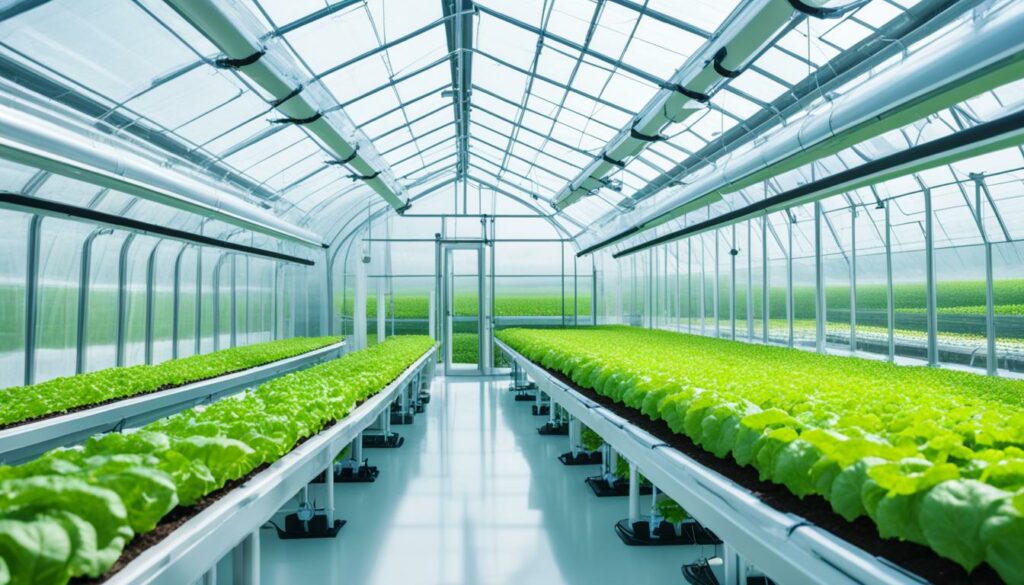
Using big data and algorithms is key in analysing farm data now. By looking at lots of data, farmers can make better choices that boost their work. Daedong’s big data system collects and checks local farm info to help in deciding. The algorithms can even forecast greenhouse temperatures and humidity. This helps in making the perfect climate for growing crops.
In South Korea, these high-tech steps are already being put into action. The country is working to turn more than 7,000 hectares of land into digital farms by 2022. This digital shift is a big deal for the future of farming. It will help farmers deal with things like old farming populations, less land to grow on, and the need for eco-friendly farming.
Now, let’s see how these techs work in real life:
| Technology | Application | Impact |
|---|---|---|
| IoT in Agriculture | Real-time monitoring of soil and climate conditions | Enhanced precision agriculture |
| Agricultural Data Analytics | Big data platform for regional analysis | Informed decision-making |
| Precision Agriculture | Drone-based crop monitoring | Optimised resource use, maximised yields |
In South Korea, precision agriculture is changing how farms work. It uses high-tech tools to check the soil and measure how much crops grow. This helps make farming more effective, especially for small and mid-sized farms.
Keeping an eye on soil conditions is key in precision agriculture. Companies like Samsung have made sensors that check soil’s moisture and temperature. Farmers then use this info to water and fertilise their crops better, leading to healthier plants and more food.
The South Korean government is also helping by setting up the “Smart Farming Industry Development Plan.” This plan encourages the use of tech in farming for a more sustainable and lasting approach.
Measuring how much crops give off is a big part of precision farming. South Korea is putting a lot of effort into using data to see how well plants grow. By using tools like Nongshim Data System’s crop monitoring and smart water systems, farmers can get tips on how to farm better. This has led to a big increase in rice production, with some fields growing 30% more rice than others of the same size.
| Aspect | Details |
|---|---|
| Market Growth | 12.3% CAGR from 2022 to 2030 |
| Farm Sizes | 1 to 2.5 acres |
| Drone Market Size (2023) | USD 298.12 million |
| Major Companies | INTOSKY, DJI Agriculture, XAG Co., Ltd |
Precision agriculture is making South Korea a leader in farming tech. With advanced monitoring and data, South Korea’s farms are ready for the future. They can grow more food sustainably and keep up with the latest in agriculture.
Smart greenhouses are a big step forward in South Korean farming. They combine high-tech environmental control with AI. This combo allows farmers to meet today’s needs while being eco-friendly.
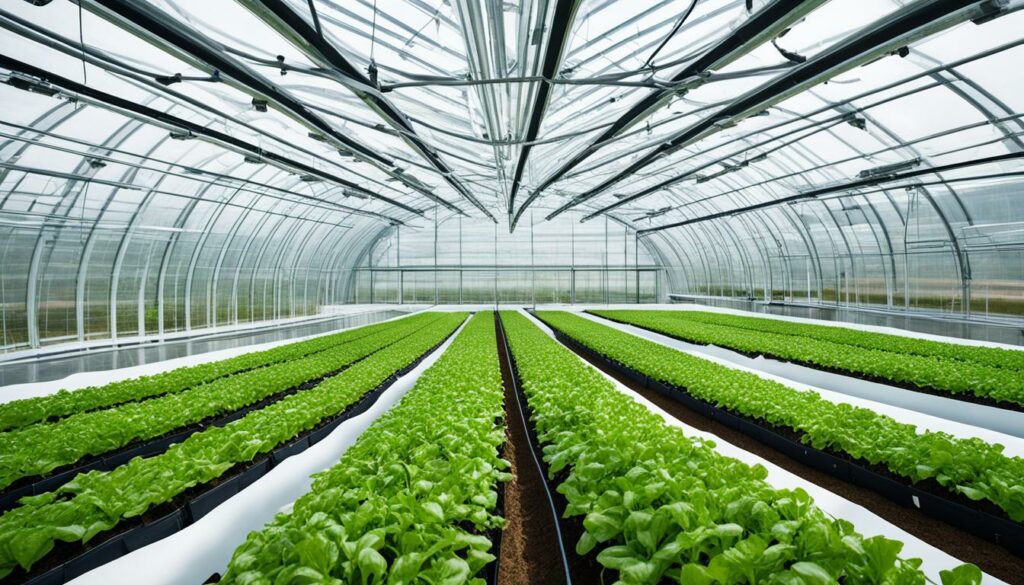
The G-Smart system keeps an eye on soil, air, humidity, and more. It makes sure plants get just what they need to grow strong. This means better crops and more food security for everyone.
These efforts help not just technically but also money-wise. A company called Digilog, with Geumsan County’s support, is bringing G-Smart to lots of farms. Thanks to Amazon Web Services (AWS), small farms get to boost their output by 5% without spending loads.
Geumsan County wants to lead in perilla leaf production worldwide. Smart greenhouses play a big part in this goal. Thanks to ongoing funding, there’s always new tech to make farming sustainably even better.
New tech in smart farming is making things easier for farmers – a big deal since many are getting older. There are lights that predict what plants need and cut costs. And smart tractors do their job with precision, saving time and effort.
IoT is really changing how we farm. Sensors and cameras watch over everything inside smart greenhouses. This detailed monitoring helps farmers use resources better.
This tech is spreading far and wide. The Cloud Innovation Center (CIC) in Busan keeps improving G-Smart with AWS. This helps farmers globally face real challenges using the latest cloud tech.
The use of drone solutions in South Korean farming has changed many things, especially in precision agriculture. Companies like Daedong use special cameras to track the plant’s progress all the way from seeding to harvest. This way, they make sure every step in growing crops is done right.
Daedong’s advanced technology is known for its AI that learns from the plant’s growth. It then creates the best environment for plants to grow, meaning less trial and error. This is really helpful for making natural materials used by green companies.
The VISION tool by Daedong shows how looking at lots of farm data helps make better decisions to grow more and better crops. They use special plans for each field, check the soil, and even use drones for applying fertiliser or controlling pests. All this to make farming as efficient as possible.
Daedong also uses AI to tell farmers exactly how much fertiliser to use. Their drones look at the crops growing and give important data. These steps, from the soil to the final crop, make sure every part of farming is improved, leading to better crops and more of them.
| Drone Model | Features |
|---|---|
| Mavic 3 Multispectral | 4/3 CMOS RGB Camera, 4 x 5 MP G/R/RE/NIR Multispectral Sensor |
| Matrice 350 RTK | Flight time up to 55 minutes, Maximum transmission range 20km |
| Zenmuse P1 | 45 MP Full-frame Sensor, TimeSync 2.0 |
| MicaSense RedEdge-P | High-resolution panchromatic band for 2cm resolutions at 60m |
| Pix4Dfields | Fast & accurate processing, Custom agricultural indices |
Finding new and better ways to grow crops, Daedong’s R&D Centre in Seoul is a key place. They use smart technology and various machinery to experiment with different growing methods, from vertical farming to growing leafy vegetables. This work is showing what future farm technology can be.
The smart use of drone solutions in farming shows how technology is crucial for a sustainable future in agriculture.
South Korea tackles global agricultural challenges with AI and robotics. These technologies change how we farm. They make farming more productive and sustainable.
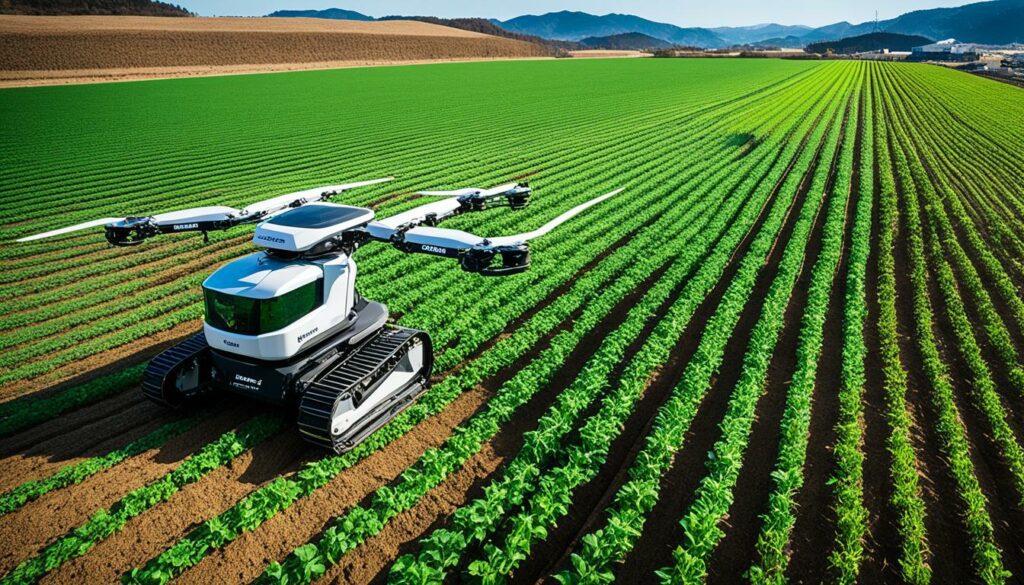
AI systems manage farm environments in new ways. They control temperature, humidity, and light for better crops. Farmers get precise data instantly, helping them grow more food and adapt to climate change.
Robotic machines that work by themselves are a big step in farming. They do tasks like planting and harvesting with high accuracy. They need less human work and make farming more efficient. For instance, machines that milk cows and pick crops have really helped.
By 2050, we’ll need 70% more food for a population of almost 10 billion. AI and robotics in farming are key to meeting this demand. South Korea leads in this farm technology, making farming better for the future.
| Technological Integration | Impact | Example |
|---|---|---|
| AI-driven Environmental Control | Optimised environmental conditions for crop growth | Real-time analytics using advanced sensors |
| Autonomous Agricultural Machinery | Increased efficiency and reduced labour dependency | Automated milking machines, crop-picking robots |
| AI in Farming | Enhanced precision and productivity | Integration of big data for informed decision-making |
South Korea’s farming scene is changing a lot with high tech and teamwork. The country’s Agriculture Ministry works with tech for better farming. This helps farmers a great deal.
The government is putting KRW 6.2 billion (US$4.7 million) into digital farming. They will work on stopping diseases, reducing smells from livestock, and improving greenhouse tech. This shows they are serious about making farming better using tech.
The government is also making it easier for new farming ideas to start. This means you don’t find as many rules stopping fresh, smart farming ideas. They’re even opening three food tech research spots to bring farming and food work closer together.
Private companies are pushing hard for digital farming in South Korea. N THING is one such company, making the world’s first modular vertical farm. Located in Seouchae, it’s a cool mix of aquaculture and plant growing, showing big private success.
Government teams and business leaders are working closely too. Together, they are creating places called Smart Farm Innovation Valleys. These are spots all over Korea for smart farming experiments and new ideas. Gimje was the first site, and more are coming, like in Sangju. This shows big plans for the future of farming in South Korea.
This work together between the government and private business is key for a high-tech farming future in Korea.
South Korea leads in smart farming, sharing its work worldwide. It shows how Korean tech can change farming globally.
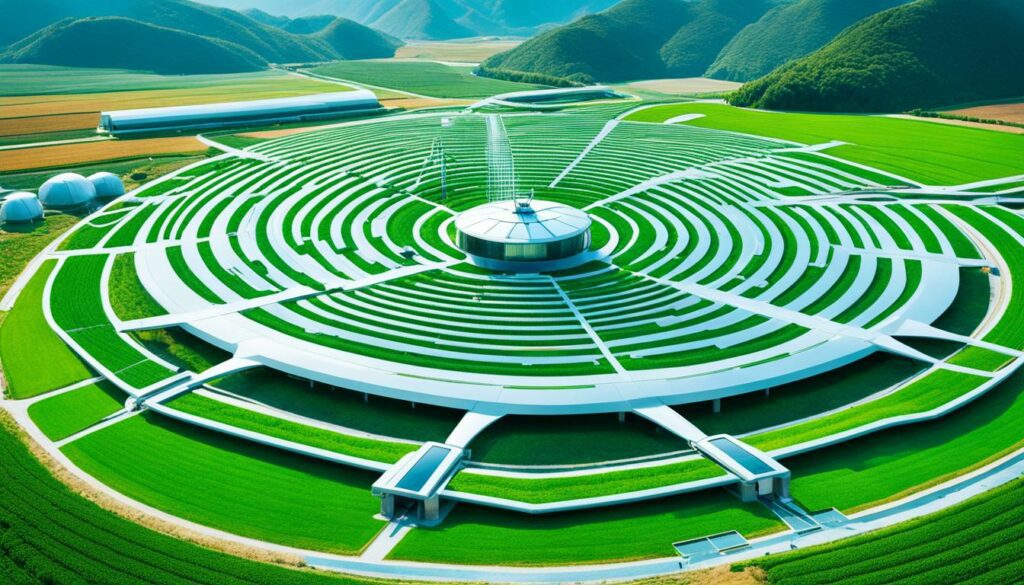
The UAE Smart Farm Project showcases smart farming in varied climates. Korean tech, like advanced cooling, makes crops thrive even in deserts. It’s part of a global effort for sustainable farming.
Oman and the Philippines got Korean smart farming know-how. Korea sent ten smart greenhouses to the Philippines for educational purposes. It proves how well Korean tech fits different places.
By 2022, South Korea plans to turn 7,000 hectares into digital farms. Companies like Daedong are leading, offering advanced farming tech. This includes managing environment and using AI for crops.
South Korea’s strong internet (99.5% coverage) helps put tech into practice easily. The number of smart tech greenhouses in Korea tripled from 2016 to 2020. This boosts farming locally and makes Korea a smart farming leader globally.
Digital farming in South Korea faces hurdles like rural internet issues. Also, it’s hard for farmers to afford new tech. Even though most Korean homes have internet, rural areas struggle. This makes smart farming tools hard to use smoothly.
Good internet is vital for digital farming to work well. It’s key for using data, IoT devices, and smart systems. The South Korean government aims to make many farms digital by 2022. But, despite the country’s top technology rankings, many rural areas still lack good internet.
The cost and learning curve of new farming tech are big blockers. These smart farming tools can be expensive. This hits small farmers the hardest. Also, many farmers are older and find new tech hard to learn. This slows how quickly digital farming can spread.
The Korean government is taking steps to help. They have projects like the “Digital Green New Deal Plan.” Also, the Korea Agency of Education, Promotion and Information Service in Food, Agriculture, Forestry and Fisheries are getting involved. These efforts are helping farmers and creating new tech data. But, more needs to be done. Helping farmers with tech costs and teaching them about new tech will take ongoing work. This way, all farmers can join the digital farming age.
South Korea shows its strong focus on sustainable farming and new technology through smart farming. In just a year, over half a million people moved from cities to the countryside to work in agriculture. This move was a 5.6% jump from the year before.
There’s been an increase in young farming households. For example, from 2019 to 2021, the number went up from 1,209 to 1,507. This shows more young people are getting into farming.
Looking ahead to 2022, we see big changes in South Korean farming. Now, there are 12,000 farmers who are under 40 years old. The government aims to have 30,000 young farmers by 2027. They want these young farmers to make up 10% of all farmers by 2040.
The country is working hard to boost its farming industry. The goal is to improve through sustainable practices and using smart technology.
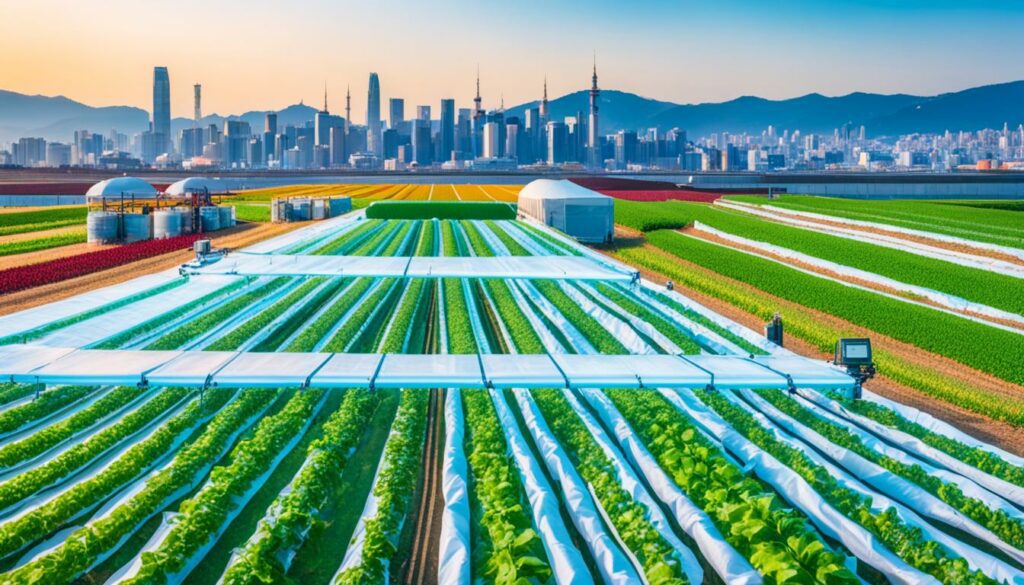
Farming is now a small part of South Korea’s economy. But, there’s a plan to make 30% of farms smart by 2027. This is important because the country produces less of its food than it used to. It went from producing 70% of its food in the 1980s to less than half in recent years.
Using smart farming is seen as a way to make farming more successful. It can help attract new people to farming and also be good for the environment.
Success stories from South Korea show how good farming practices and technology can lead to success. They inspire other countries to learn from South Korea’s approach. Mixing new technology with traditional farming can be very positive.
Their government’s plans are also very important. They show other countries a way to support farming and protect the environment. South Korea’s work in smart farming makes it a leader in this area.
The future of agriculture in South Korea is exciting. It’s all about creating rural areas that can sustain themselves by using new technological innovation in farming. The area used for farming has gone down by 29% since 1975. But, this has pushed towards smart agriculture growth.
Even though the farming space has got smaller, more greenhouses are going up. This change shows a move towards more efficient ways of farming.
About 46% of farmers in South Korea are over 65. This old age is a big problem for making sure we have enough food. But, with nearly everyone in the country using the internet, there’s a big chance to introduce smart agriculture. This means using the internet to farm better and machines to help out.
The government is also lending a hand, setting a goal to turn certain farms into high-tech ones by 2022. They’re aiming to share South Korea’s farm tech with other countries like the UAE, Oman, and the Philippines. They’ve gathered experts to help make this happen.
A company called Daedong is at the forefront of these changes. They use drones with special cameras to collect important farming information. Their technology helps to make the best environment for plants to grow. This results in better harvests and quality of crops.
Daedong also has a big database that gathers farming information from many places. This information helps farming businesses a lot. For example, their research centre in Seoul works on making farms work automatically. They use things like LED lights, machines that feed plants, and robots for checking how the crops are growing.
| Year | Key Development | Impact |
|---|---|---|
| 2019 | Reduction in cultivated areas by 29% since 1975 | Transition to smarter, more efficient farming methods |
| 2020 | Increase in greenhouse areas by 7.2% | More controlled and efficient farming environments |
| 2022 | Conversion of 7,000 hectares to digital facilities | Enhanced productivity and sustainability |
The path ahead for smart agriculture development looks really good. As we move forward, we’ll be spending a lot on fighting diseases and controlling the environment to grow food better. This will keep Korea leading the world in farming technology.
South Korea is pushing its farming ahead by focusing on new tech. They invest in vertical farming to improve how they farm. This helps use space better and look after the land well, making food production stronger.
The country is serious about making farming smarter through vertical farming. This smart way of farming fits well in a place with little land and few young farmers. Modern tech like ICT and IoT lets these farms grow more food with fewer resources. This move helps South Korea be a leader in modern farm techniques, keeping food production strong and smart.
Getting better in farming tech means more research and development (“R&D”). South Korea is doing a lot here, thanks to EPIS and its work in ICT and smart farms. By boosting its R&D centres, South Korea is creating new options for farms. This makes the country stand out in the world’s farm markets.
By focusing on vertical farming and tech research, South Korea is making its farming future-proof. This way, the nation tackles farming issues head-on while building a greener, smarter farm sector.
Digital farming in South Korea means using ICT, IoT, big data, and AI in agriculture. The goal is to make farming more efficient, sustainable, and resilient.
The government supports smart agriculture through policies and plans. They aim to turn traditional farms into high-tech ones.
Digital farming is vital in South Korea because of its limited resources, small arable land, and climate challenges. It helps use resources better, increase productivity, and make sure there’s enough food.
ICT, IoT, big data, and AI are essential in smart farming. They help in monitoring, managing resources, and making decisions based on data.
In South Korea, precision agriculture uses techniques like monitoring soil health and measuring crop yields. Daedong is leading in applying these methods to farming.
Smart greenhouses in South Korea use automation and AI to grow crops all year. They boost yields and help ensure there’s enough food. They are also seen as a good model for others to follow.
Drones are important in South Korean farming for their detailed crop and soil checks. They use special cameras to keep an eye on growing crops and know the best time to harvest. This makes farming more efficient.
In South Korea, AI and robots help control the environment, grow crops better, and do precise farming tasks. This advances farming towards being less reliant on human work and more productive.
Some challenges in South Korea for digital farmers are slow internet in rural areas, high tech costs, and the need to learn new tech. This is hard for small farms.
South Korea’s smart farming is seen in projects like the UAE Smart Farm and smart greenhouses in the Philippines. These show how Korean tech can help farmers worldwide.
In the future, South Korea is looking to focus on vertical farming, more research centres, and adding AI and ICT in farming. This will boost productivity, help fight climate change, and support older farmers.